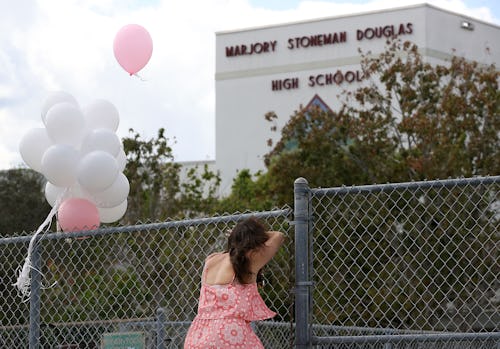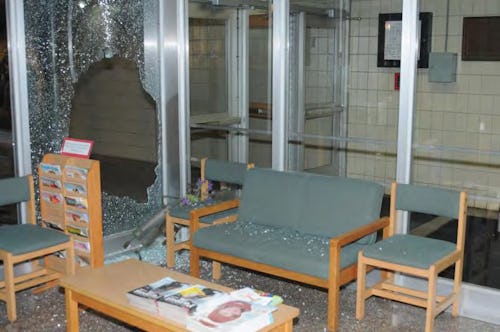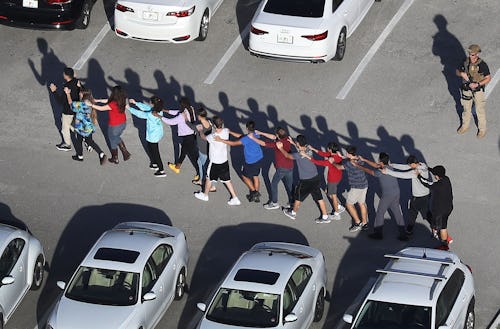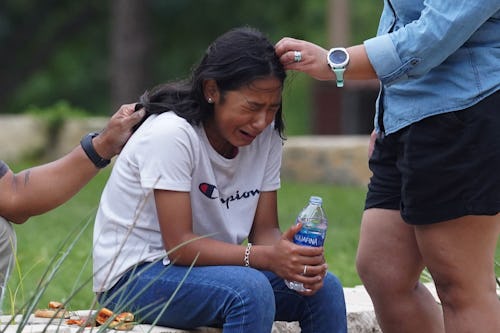
This spring, mass shooting debates heated up once more following the elementary school shooting in Uvalde, Texas, which took place only 10 days after a mass shooting in Buffalo, New York. Online, some began calling for the release of graphic mass shooting images, believing the devastation would force lawmakers into action. Experts, however, don’t seem to agree with that analysis.
These conversations aren’t new. After the Sandy Hook shooting in 2012, the families of victims debated whether releasing graphic images would be useful. Lenny Pozner, whose 6-year-old son, Noah, died at Sandy Hook Elementary School, thought about showing what the shooter’s AR-15-style rifle had done to his son’s body. The New York Times wrote: “His first thought: ‘It would move some people, change some minds.’ His second: ‘Not my kid.’”
Since Uvalde, these discussions have reignited, with many invoking Mamie Till’s decision to open her son’s casket. While mainstream media outlets generally refuse to publish such graphic images on ethical grounds, some journalists are siding with these calls. Immediately after the Uvalde shooting, Nancy Barnes, NPR’s senior vice president for news, tweeted, “We cannot sanitize these killings. That in and of itself is an editorial decision.”
In a Philadelphia Inquirer column, journalism dean David Boardman and interim medical-school dean Amy Goldberg of Temple University urged journalists to “show the bodies,” writing, “Put on display — in newspapers, on television, across the internet — a photograph or three that can, finally, help the American public understand exactly what happens when a weapon designed for modern warfare is unleashed on innocent, unarmed people. Like a 10-year-old at school.”
When it comes to releasing graphic images, there’s a lot to consider. First: Mass shooting images can often be found online anyway, often because of the shooter themselves. The Buffalo shooter, for example, streamed the event on Twitch. Although the platform took the stream down, the video spread online. I accidentally watched a portion myself. There are no words to describe how I felt after.
But as these debates continue, there are experts with words of caution. The frustrations people feel over the U.S.’s lack of action to end mass shootings is understandable. However, psychologists interviewed by Mic warned that releasing graphic images for their shock value may only re-traumatize communities — without necessarily spurring politicians to act in the way we hope. Here’s what they had to say. (Responses have been lightly edited for length and clarity.)
Victor Schwartz, Stanford Media and Mental Health Initiative
As awareness grew about more media covering mental illness and suicide, there was recognition that there was a need for mental health clinicians, journalists, and people in the media and the arts to be aware of the impact of safe reporting on mental health and suicide. That in fact, unsafe reporting or portrayals of mental illness could both increase stigma but also impact risk for suicide contagion (when suicide is not presented safely).
Like with so many of these kinds of national tragedies, my reaction is that the issue is very complicated. I understand that there is a compelling and important argument to be made that if people were to see the devastation perpetrated by firearms — and especially higher intensity, more military-type weapons — this could lead to stronger public outcry and stronger pressures on policy makers to limit or prohibit these kinds of weapons. This may very well be correct and a valuable consideration.
The concern of those of us who work in suicide prevention and media is that it could also be the case that images that would be disturbing to many people might be exciting or enticing to people who might be at risk for dangerous behavior. As an analogy, we learned that “scared straight” approaches to drug misuse prevention often failed because while many people were frightened by hearing about the risky and dangerous consequences of drug use, some people at risk for drug misuse tend to be thrill-seekers and find these kinds of disturbing messages to be exciting — thus actually inadvertently raising their risk of drug misuse. We would not want to put out images that are going to increase the risk of copycat events.

Further, these graphic pictures could certainly traumatize others who have been victims themselves, lost friends and family or others to gun violence, or have experienced other traumatic events. It is actually difficult to assess this risk of potentially encouraging copycat behavior or how many people would be [negatively] emotionally impacted against the potential to make helpful impact on public policy and thus ideally prevent future shootings.
[If these images were released], it would absolutely be important to provide warnings to people who might consume these images. They should not be included in the first page or lead of the story, and ideally maybe require a link and even an age affirmation before accessing them. There is already guidance around reporting on mass shootings. I was part of the group that helped to develop this document.
Dana Garfin, University of California at Los Angeles
I am a psychologist with expertise in stress and trauma, with a particular interest in understanding responses to collective trauma. Collective trauma are large-scale events that impact the populace broadly through both direct and media-based exposure. I have studied the psychological effects of direct and media-based exposure to collective trauma including 9/11 terrorist attacks, the Boston Marathon bombing, hurricanes, earthquakes, the climate crisis, COVID-19, shootings, and the Ukraine war.
I think the potential benefit of releasing graphic images should be balanced with the potential negative psychological consequences of exposure to those images.

Our data demonstrated that exposure to more graphic images of blood and dead bodies was associated with increased acute stress and impairment in social and work functioning even months after that exposure. We know more generally that high levels of media exposure to crisis is associated with acute and post-traumatic stress, anxiety, depression, and functional impairment. However, it may also bring awareness to a catastrophe, motivating action for change (e.g., implementing gun restrictions, red flag laws, improved safety and mental health protocols etc.).
[If released], these images should be used judiciously, if at all. It is also difficult because children will also likely see these images, and research has demonstrated media exposure to crises can have negative impacts on child mental health as well.
We must act carefully to inspire action without causing vicarious traumatization via media exposure to graphic images.
Sarah Lowe, Yale Trauma and Mental Health Lab
I am a clinical psychologist and associate professor of social and behavioral sciences at Yale School of Public Health. I conduct research on the long-term mental health consequences of a range of traumatic events, with an emphasis on collective trauma.
My first reaction [to calls to release graphic images] was one of concern — concern not only for the victims’ families and other loved ones, but also for the general public.
Regarding the families and loved ones, I wondered about the potential negative psychological consequences of the images being distributed, especially since research shows that losing a loved one in a mass shooting is already associated with heightened risk for a range of mental health symptoms, including post-traumatic stress, depression, and anxiety. Releasing images could lead to further stressors, including more contact with the media — at least one prior study has shown that contact with the media can be distressing for some survivors.

I would also worry that this might further open up families to conspiracy theories, which seemed to be extremely psychologically damaging for many of the families who lost children in the Sandy Hook tragedy. Even if parents gave permission to release the images, I would wonder about others who might also be adversely affected by their distribution, such as siblings, extended family members, or close friends. I would worry that the decision of whether to release images could lead to tensions within the family, which could also exacerbate mental health risks.
For the general public, I would be concerned that widespread exposure to graphic images could lead to heightened post-traumatic stress, anxiety, and depression, particularly among those with risk factors for adverse reactions, such as those with pre-existing mental health conditions or previous trauma exposure. Research has shown that exposure to graphic images increases mental health risks.
Theoretically, it has been said that, since humans did not evolve with modern technology, some part of our brain responds to photographs and videos as if we are experiencing them in front of us, even though we are cognitively aware that the events depicted are not occurring — thus evoking emotional responses. The more I thought about the issue, though, I wondered whether there would be a way to release the images that could minimize risks.

[If images were released], I would want the victims’ families to be informed about their potential risks and benefits in releasing the images, and ideally to be able to revoke their consent to distribution if they ever so choose. Their well-being should be prioritized.
Second, I would hope that there would be strategies to ensure that images are not distributed beyond family-approved media outlets, used for purposes other than those supported by the families, or altered in any way. (I’m honestly not sure what these strategies would be, though).
Third, I would hope that media consumers are warned about the potential dangers about viewing graphic images and they would have to pass at least one barrier to seeing the images. The images should not be shown alongside the text by default, and should not be retrievable via an image search (if that’s possible?). I would also want consumers to be given information about what they can do if they are experiencing any mental health symptoms (as a result of seeing the images or otherwise). It might also be useful for consumers to attest that they will not further distribute or alter the images without permission.
Fourth, media outlets should provide consumers with evidence-based steps that they can take to help reduce mass shootings and other forms of gun violence. Graphic images will elicit emotional responses that should serve a purpose — anger and sadness can spur action, but a person needs to know what actions to take. Without a set of possible behaviors, I would worry that some consumers would feel a sense of hopelessness and helplessness, contributing to long-term mental health risks. (That said, I would also worry that having an accompanying set of behaviors would fuel conspiracy theories and be perceived as somehow partisan ... I am not sure how to get around this, but perhaps providing links to sources to support suggested behaviors would help?)







